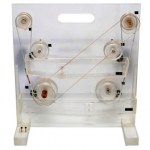calendar photo
December's calendar photograph is a battery of five solar cells that also stores electricity in series. The cells were invented and developed at the Weizmann Institute in the late 1970s. These not only converted sunlight into electricity, but also could store some of that energy using a battery-type setup with electrodes in a chemical solution, so that they could provide electricity day and night.
The idea of efficiently storing solar energy has taken more than one twist and turn since then - various forms of artificial photosynthesis, for example. Interestingly enough, one of the latest…
We don't mean to kvetch, but the new website we promised back in June is still as elusive as cold fusion. Scientific research, of course, is going strong, and we even continue to write about it, but no one can read about it on our website (and therefore, we can't offer links to articles on the newest findings).
In the meantime, here is the October image from our 2010-2011 calendar:
It looks like quite a simple apparatus, but in many ways, it was far ahead of its time. It was called a mechanochemical engine, and it was created at the Institute in the 1950s by Prof. Aharon Katzir. Katzir…
The Dot Physics game inspired us to put up this photo from the Institute's new calendar,* which features images of (mostly) old scientific equipment.
In case you haven't guessed, it was called a "tamnun" (Hebrew for octopus) or, more formally, a Multi-Counter Gamma-Ray Goniometer. It was developed (and patented) at the Institute in the 1970s for use in Tandem Accelerator experiments. The multiple movable arms are meant to grip up to six gamma-ray detectors at precisely calculated angles.
Patent notwithstanding, it does not appear to have been a huge seller, and even the old-timers here were…


